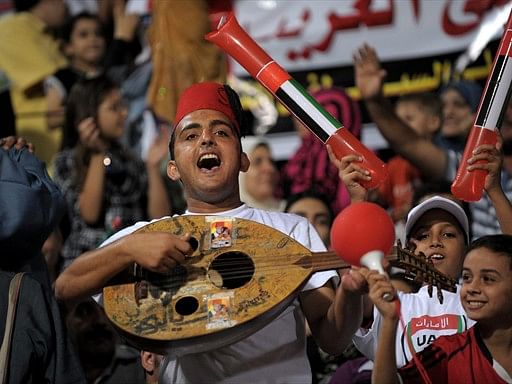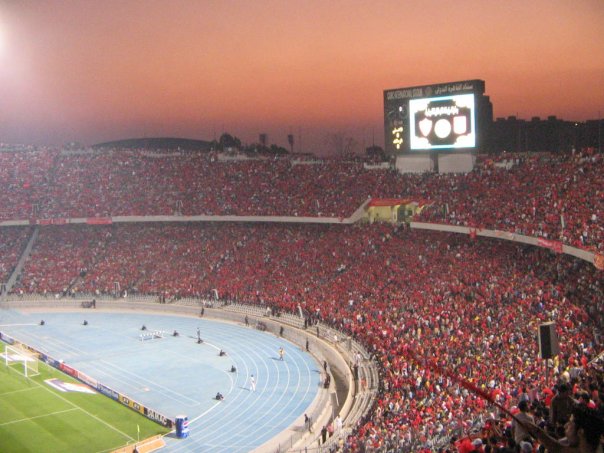
Kickabout in the desert sands - A different perspective on Arab football
I’m quite sure that many of you thought of Manchester City and Paris Saint-Germain when you read the title. I can’t blame you for that; today, the words ‘Arab’ and ‘football’ are more likely to form an image of billionaire owners bankrolling title challenges rather than one of kids kicking a ball about on the streets of Dubai or Cairo. That’s sad. Sad, because football in the Arab World isn’t all about the rich sheikhs. I should know – I lived there for 18 years.

An Arab football fan
Misinformation, stereotypes and outright ignorance about Arab football are so widespread that the real facts are not conspicuous. There is lot of hate too, due to various reasons. What I intend to do in this article is simple – I want to show the face of Arab football as I know it and in doing so, I hope I clear the air and set the record straight.
History is always crucial to understanding the present. It was early in the 20th century when the game arrived in the blazing desert via the colonial powers and oil workers. What was initially a foreign delicacy quickly caught the imagination of the masses. So much so that football had turned into something of their own. In the next few years, teams started springing up in different parts of the region. History shows that Europeans played a major role in founding some clubs, especially those in Egypt like Al Ahly and Zamalek. Their involvement was no doubt important for the growth of the game; yet the fact is that passionate Arabs themselves took the lead later. The North Africans were the trendsetters when it came to establishing national leagues; the others followed suit once the foreign powers had left. The oldest leagues in the Arab World are those of Tunisia (1921), Egypt (1948) and Morocco (1956).
As with most other people, Arabs had a hard time in the mid-20th century. It was a turbulent period filled with wars, revolutions, coups and counter-coups. What is amazing is that football continued undeterred on its upward trajectory.
At the international stage, Egypt made an appearance at the second-ever FIFA World Cup held in Italy in 1934. Seven other teams have emulated the Pharaohs since then, with Morocco, Saudi Arabia and Tunisia qualifying four times each. From 1982 till date, the average number of Arab teams participating in the tournament is 2. Without a doubt, how you perform once you get there is what is noticed and not how many times you make it. Looking at their track record, Arab teams haven’t had it as they would have wished to. Yet there have been a few occasions when they sent pulses racing across the region due to their exploits at the Cup.

Algeria battled the imperious West Germans in 1982
In 1982, Algeria made its first appearance at the World Cup and quickly made its mark when Rabah Madjer, Lakhdar Belloumi and co. orchestrated a famous 2-1 upset over West Germany. They later lost to Austria but finished off their group stage with a win over Chile. On the final day, West Germany were set to play Austria. A win by one or two goals for West Germany would result in both of them qualifying at the expense of the Algerians. After 10 minutes, West Germany took the lead. Neither team scored after that. They didn’t create many scoring chances and gave the impression that the match was fixed, with a boring, just-not-football display. Fans showed their disapproval and Algerian officials complained but to no avail. With West Germany winning 1-0, the Algerian dream was over and they were on the return flight home, frustrated and disappointed.
In 1986, Morocco topped a group containing England, Poland and Portugal, thereby becoming the first Arab or African team and the second team from outside Europe and the Americas to make the second round of the World Cup. The magnitude of this feat was still on their minds when they lined up against West Germany in the Round of 16. They did not disappoint, holding the Germans to a goalless stalemate until the 87th minute when Lothar Matthäus popped up to score the winner. The Moroccans went home with their heads held high, reflecting on a landmark achievement. It was an achievement which would be replicated eight years later, but by another team, in the United States.
The Moroccans qualified again in 1994 and this time they were joined by debutants Saudi Arabia in Group F. However, they didn’t win a single match this time around. After losing to Belgium, they played the Saudis in an all-Arab game and lost out 1-2 with Saudi star Sami al-Jaber opening his World Cup account with a penalty (He would go on to score in two more World Cups, joining an elite list of players who have done so). By the end of the group stage, the Saudis were the ones hogging the limelight, defeating Belgium to get into the Round of 16 thus emulating the Morocco team of ’86. The Saudi-Belgium match saw one of the best goals in World Cup history. Saeed al-Owairan ran through an entire half, twisting and sliding through a host of Belgian defenders and whacked the ball past Michel Preud’homme, scoring what was later voted as the sixth best goal in FIFA’s Goal Of The Century poll. The Saudis got knocked out by Sweden in the Round of 16, but they, just like the Moroccans eight years ago, had a tournament to remember.

Al-Owairan doing his bit
The World Cup story ends there. That’s it. There hasn’t been any standout Arab performance ever since. So much for footballing pedigree, one would say. But can we seriously measure footballing pedigree just by a World Cup record? I say the Arabs proved they can play football too in the above cases, despite not having “international-standard footballing pedigree”. Who needs pedigree anyway? Within their constraints, and despite the political turmoil that ravages the region, they have done a lot. Quite a lot. An endless passion for the game and enthusiasm that amazes you – isn’t that what matters? That could be put up for debate, a heated one I’m sure. While that is being debated, I would like to bring your attention to some other issues.
Cast your eyes to the international youth tournaments. Saudi Arabia were champions of the FIFA under-17 World Cup in 1989. Qatar and Oman finished fourth in 1991 and 1995 respectively. In 1981, Qatar were runners-up at the FIFA under-20 World Cup, after beating Brazil and England on the way to the final. Egypt was third in 2001 and Morocco fourth in 2005.

Madjer wins it for Porto
Forget Arab teams as such, Arab players have punched above their weight. A sizeable number of the French national team of recent years, trace back their roots to the Arab desert. When you see Zinedine Zidane volleying that goal against Bayer Leverkusen in the Champions League final, you witness exquisite part-Arab, part-French beauty. When you see Sami Khedira holding his team together, you admire the few shades of Arab toughness at display. When you see Samir Nasri or Karim Benzema tricking and powering their way past defenders, you enjoy some watts of Arab power. But when you see Rabah Madjer back-heeling Porto‘s way to victory in CL ’87, you stare open-mouthed at pure Arab cheekiness. And when you see Ali al-Habsi stop shot after shot to defend Wigan’s goal, you applaud sheer Arab resilience coming straight from the sands of the Omani desert. And there are many more cases like Madjer and al-Habsi where Arabs have beaten the odds to shine at the highest levels. Saeed al-Owairan is one such example. QPR’s Adel Taarabt is another. Montpellier’s Younes Belhanda is yet another. And the number of Arab players (real Arab players, not those of Arab origin) raising eyebrows in France or Holland today is just too high to explain each case here.

Al-Habsi – Wigan’s Saviour
And why look at only Europe or the World Cup? Football is played outside that too. In Africa, Arab teams have won the Champions League twenty-five times between them! Egypt are seven-time continental champions – that’s a record. Come to Asia, there is an obvious domination by the East Asians but despite that, Al-Ittihad, Al-Hilal and Al-Sadd have managed to win two Champions League titles each. Al-Ittihad and Al-Ahly both qualified for the FIFA Club World Cup in 2005. Ittihad defeated Ahly and went on to have two hard-fought matches – losing 2-3 to eventual winner Sao Paulo and Deportivo Saprissa. Al-Ahly qualified again in 2006 and finished third in a memorable tournament, where their star Mohammed Aboutreika finished as the top-scorer. Al-Sadd did the same in 2011, finishing behind Barcelona and Santos.

As humble as ever – Aboutreika offers his thanks to God
Talk about pedigree now. Go on.
And now, last but not least, we move on to another issue. It is quite widely believed by the general ignorant public that Arabs have far more to do with suicide bombing and flying planes into skyscrapers than any kick-about. So is that true? It’s a rhetorical question that needs to be answered. I, for one, can assure you that a typical Arab football fan is just as passionate about the game as you and me, the chap in that London pub, the Bengalis who squeeze in front of a small set, or the kids from Rio who shed tears when their team disappoints. When Barcelona battles with Real Madrid, you’ll find Arabs clad in Messi and Ronaldo jerseys with a craze that equals that in Spain. Even in the Arab World, derbies like Ahly-Zamalek or clasicos like Ittihad-Hilal can create an electric atmosphere quite similar to those in other parts of the world. Songs, drums, banners, flares and crazy Italian-style ultras – they have it all too.

Fans at the Ahly-Zamalek derby
Yes, we’re all different but in this particular case, football unites us all, just as a global language would. It is in football that we discover that maybe those differences weren’t really differences. Maybe we’re all the same. We laugh, we cry, we jump out of the seat at that last minute equalizer – we have a lot in common. We have the same emotions running through us when our team concedes an early goal, when we make an unbelievable comeback after being three goals down, or when our favourite player gets sent off. What you see of football in the crowded public park, the pub full of whackos, the talented kids at the beach, the street, the alleyways and the broken windows – the same passion is present in Arab blood too. I vouch for that.
So out with the hate!